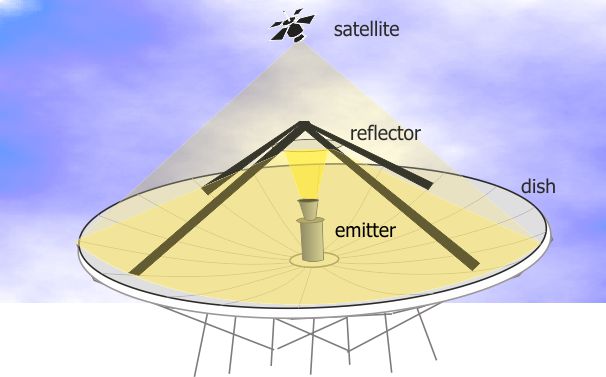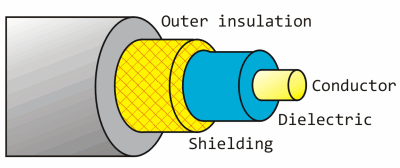Freesat reception - all about dishes
 Brian Butterworth published on UK Free TV
Brian Butterworth published on UK Free TV Satellite reception has both advantages and disadvantages compare with terrestrial (aerial) reception.
By using much higher frequencies (gigahertz, compared to terrestrial televisions megahertz) more transmission channels called transponders (the satellite equivalent of multiplexes) can be provided. For example, there are only six Freeview multiplexes, but Sky or Freesat users can access two hundred satellite transponders.
Aside from exceptional weather conditions (very heavy rain for example) digital satellite provides stable pictures and audio. Where Freeview transmitters are no more than 732 metres above sea level, the geostationary satellites used for television are 35,800,000 metres above the equator so reception is possible even where buildings, trees and hills make terrestrial reception impossible.

The downside of the transmitters being 22,300 miles up in the air is that the signals are very, very weak - so standard TV aerial is of little use. When the signals are sent to the satellites, huge dish transmitters are used to uplink the signal to the satellite. These are tens of metres from side to side, and feature an emitter that generates the signal, which is first bounced of a mirror (called a reflector) and then off the surface of the parabolic dish.

There are many satellites in the sky over the equator. Often these are in clusters over a particular position, for example there are four used for UK television are at 28.2 degrees east. There is another cluster over the 19.2 degrees east positions that are used for German television.
To receive these very weak signals from the satellite, it is necessary to use a dish for reception too. By using a reflective dish, this concentrates the signals onto a small device called a LNB. This is held in front of the dish by a metal arm.

The size of dish for reception is typically much smaller; often 60cm to 100cm in diameter, but the exact size depends upon the transmitting satellite transponder. To keep the transmission power levels down to levels that can be powered by the satellite's solar panels, each beam is focused on a particular area of the Earth's surface. If you are trying to receive the signal at the centre of this zone, a small dish is required. At the outer edges, you may need a 5 metre dish. Maps of these zones are provided by the satellite companies, and are called satellite footprints.
When the dish is installed it must be aligned carefully as the signal is very weak. The installer needs to know the inclination and the azimuth from the ground location to the satellite. If you install yourself you will find that there are markings on the dish that are used to point the dish in the correct position. It is important that the view of the satellite will not be blocked, so must take into account leaves growing on trees and potential building works.
For many people the LNB will have a single cable connected to it, however if you have Sky+ or a multi-room installation the LNB package will actually contain four receivers a quad-LNB. Unlike terrestrial television where you can split the aerial cable to feed more than one Freeview box or television set, with satelite reception you cannot. So, a Sky+ box with two receivers (so you can watch one thing and record another) has two cables connecting the box to the dish.
The cable that connects the dish to the receiver must be satellite grade cable. Whilst this looks superficially like the cable used to connect and aerial to a television, a higher grade cable is required for satellite reception.
Here is an image of a co-axial cable. This sort of cable is used to connect any type of receiving aerial to the reception equipment.

RG6, PF100 and PH100 are all types of coax cable that are suitable for the very weak signals that are received by a satellite dish. (The power is the same as you would receive from a one-bar electric heater on the moon).
The conductor in the centre passes the signals received from the dish to the set-top box. This is made from steel in RG6 cable, and from copper in the RF100 and PH100 types. This makes RG6 less suitable in the UK where rain can damage the cable.
The shielding is responsible for keeping unwanted external interference from damaging the signal. In the cheaper cable this will be a foil wrap, in better specified cables this is a braid (or mesh) of copper wires. The sheild in the RF100 covers 58% of the cable.
The non-conducting layer between the shield and the conductor is called the dielectric. This can be either a solid (RG6), foam (RF100) or air-spaced (PH100) dielectric. This makes the cables progressively more flexible (ie bendy without damage).
7:53 AM
Wrexham
Is there anything on this site about recent footprint changes affecting S of France watching UK tv??
| link to this comment |
Steve's: mapS's Freeview map terrainS's terrain plot wavesS's frequency data S's Freeview Detailed Coverage
Steve P: They are shown on the Satellite footprint maps | ukfree.tv - 11 years of independent, free digital TV advice page...
| link to this comment |
... also New Astra 1N satellite to offer more UK-focused capacity - and soon | Free satellite - general | ukfree.tv - 11 years of independent, free digital TV advice ASTRA 1N satellite has entered commercial service | Free satellite - general | ukfree.tv - 11 years of independent, free digital TV advice BBC satellite services moving to Astra 1N on 24th February 2012 | Free satellite - general | ukfree.tv - 11 years of independent, free digital TV advice Good news for Freesat? Astra 2E satellite launched | Free satellite - general | ukfree.tv - 11 years of independent, free digital TV advice
| link to this comment |
10:25 AM
Hi could you tell me please if ineed abigger satellite I have a 4 point dish with 2 freesat boxes on and sky box but all freeze now and again if this because dish is not big enough thanks Mark.
| link to this comment |
11:26 AM
mark kelly: #1) Where are you? If in the UK , get a local installer to check for a possible failure. #2) What size dish do you have now? #3) Do ALL satellite channels freeze? Some channels have not changed in coverage area when the public service ones have gone onto a tight 'UK only' beam. With the detail given, to be able to pinpoint your problem is not possible.
| link to this comment |
12:43 AM
mark kelly : If indeed you are a resident of the UK mainland, then carry out a signal strength / quality check on the Sky box (not Freesat), if both the S&Q indications are around 70%+ then thats OK, if though the quality is lower than the strength then the dish requires slight re aligning, this usually always being in the horizontal (Right / Left) plane.
Should both both indications be around that mentioned, then as you have reported that this problem affects all boxes the problem could possibly be caused by the dish not having a continuously clear view of the S/SE sky line, maybe by being intermittently obstructed by such as tree foliage etc, or that the dish to wall mounting is slack and is allowing the wind to move the dish, as only the very slightest of movement will knock the picture out!
As far as dish sizes are concerned, zone 1 dishes are OK for Southern England, Zone 2 (as used in Scottish installations) being better by capturing more of the signal.
| link to this comment |
9:51 PM
hi there, i have a free sat and a sky box connected to my tv by using a splitter on the saterlite input, i have been able to receive freesat and sky until few day ago which says "LNB" overload detected on my freesat and "no signal" on my sky. i would be very greatful if you could give some advise, i have a communal dish.
thank you.
| link to this comment |
12:05 AM
shahera: You cannot use any form of splitter on the output from a satellite dishes LNB, as a satellite box (any type) sends control signals (voltages & tones) back to the dishes LNB instructing it to switch bands as well as polarities, any more than one box connected into the system being liable to clash with each other dependent on the channel selected.
If you wish to use a Freesat box as well as Sky box "at the same time" as each other, (two rooms) then this requires the LNB fitted on the end of the dish arm being changed for a quad (4 output) type, this then enabling both a Sky and Freesat box to operate independently of each other.
By the way, the quad block was mentioned purely because that dual output types are considered obsolete, and if the LNB is changed, then another cable will have to run from the LNB to wherever the box is located.
You can of course use a Sky box "or" a Freesat same on a single downlead, but only provided that the output from the LNB is fed into a two way switch designed for satellite operation.
| link to this comment |
I'm in Cornwall and for the last few days we have 2 televisions with no signal and the large tv in the lounge is working with no problems. What can I do.
| link to this comment |